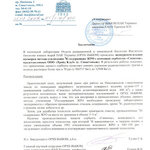Chemistry

Specialists of companies «Trade Club» Ltd and «Sinkopa-K» Ltd Sevastopol, own technology of «Utilization tritium of containing liquid radio-active wastes » based on application of sorbents « Sinkopa». Verification of method of utilization tritium of containing liquid radio-active wastes by sorbents «Sinkopa» was conducted in August, 2009 in the isotopic laboratory of Department of radiation and chemical biology of Institute of Biology of the Southern Seas (IBSS - www.ibss.org.ua) of National Academy of Sciences of Ukraine. As a result of work it is shown, that…

Researchers from NIST and the University of Maryland have found what they say is a simple method of sandwiching organic molecules between silicon and metal, two materials fundamental to electronic components - perhaps overcoming one of the principal obstacles in creating switches made from individual molecules, the ultimate in miniaturization for the electronics industry.
The idea of using molecules as switches has been around for years, carrying the promise of components that can be produced cheaply in huge numbers, perform faster as a group than their larger silicon brethren, and use only a…

After taking a new approach to developing an effective "electronic tongue" that mimics human taste, scientists in Illinois are reporting development of a small, inexpensive, lab-on-a-chip sensor that quickly and accurately identifies sweetness — one of the five primary tastes. It can identify with 100 percent accuracy the full sweep of natural and artificial sweet substances, including 14 common sweeteners, using easy-to-read color markers. This sensory "sweet-tooth" shows special promise as a simple quality control test that food processors can use to ensure that soda pop, beer, and other…

This really belongs in a general science category, but because of the nature of the experiment I post it here in the field of chemistry.
Experience is the best teacher. "The great Roman leader Julius
Caesar recorded the earliest known version of this proverb, 'Experience
is the teacher of all things,' in 'De Bello Civili' (c. 52 B.C.). Reference.
This experience stems from the idea of lipid peroxyl radical production of fatty acids by lipoxygenase using an electron spin resonance spectrometer (ESR). While we had other experiments lined up while visiting the University of…

An insulator can now be transformed to conduct electricity by an ordinary camera flash, says a Northwestern University professor and his students who have found a new way of turning graphite oxide, a low-cost insulator made by oxidizing graphite powder, into graphene, a hotly studied material that conducts electricity. Graphene is the material du jour in studies to produce low-cost carbon-based transparent and flexible electronics.
Previous processes to reduce graphite oxide relied on toxic chemicals or high-temperature treatment. Instead of that, the Northwestern folks kept it simple,…

Despite the overwhelming abundance of water on the planet and in our lives, the molecular structure of water has remained a mystery.
In all, water exhibits 66 known anomalies, including a strangely varying density, large heat capacity and high surface tension. Contrary to other "normal" liquids, which become denser as they get colder, water reaches its maximum density at about 4° Celsius. Above and below this temperature, water is less dense; this is why, for example, lakes freeze from the surface down.
Water also has an unusually large capacity to store heat, which stabilizes the…

The human eye lens consists of a highly concentrated mix of several proteins. Protective proteins keep them from aggregating and clumping. If this protection fails, the lens blurs and the patient develops cataracts. Two research groups at the Department of Chemistry of the Technische Universitaet Muenchen (TUM) have succeeded in explaining the molecular architecture of this kind of protective protein. Their findings, which are published in PNAS (Proceedings of the National Academy of Sciences).
Cells have a variety of protein complexes that manage vital tasks. The functions of these "…

Now we can contain whales in our starships!(sorry for just pasting and running, really busy...)
"Scientists claim to have created a form of aluminum that's nearly transparent to extreme ultraviolet radiation and which is a new state of matter."
Click here for full story.

The phenomenon of Brownian motion (after botanist Robert Brown, who discovered it 1828) was described by Albert Einstein in 1905, when he published his statistical molecular theory of liquids. Brownian motion is basically the random movement of particles within a fluid. As a new study by University of Illinois scientists shows, Brownian motion is, perhaps, not as mathematically applicable as previously thought. Einstein thought if the motions of many particles were watched, and the distance each moved in a certain time were recorded, the distribution would…
A team of scientists say they have discovered a method for attaching molecules to semiconducting silicon that may help manufacturers end-run the current limits of Moore's Law in the quest to make microprocessors smaller and more powerful. Moore's Law is named after Intel co-founder Gordon Moore who said in 1965 that the number of transistors that can be placed on an integrated circuit doubles about every two years. But even Moore said the law cannot be sustained indefinitely. Or can it?
The challenge is to get past the limits of doping, a process that has been essential to…